Physical Address
304 North Cardinal St.
Dorchester Center, MA 02124
Among the herpesviruses, HSV-1 and HSV-2 are most closely related, with approximately 60% genomic homology. Historically, HSV-1 was more frequently associated with nongenital (especially orolabial) disease and HSV-2 with genital disease, but that distinction has become blurred with the recognition that HSV-1 causes more than half of initial genital herpes infections in some populations. These two viruses can be distinguished most reliably by DNA analysis, but differences in antigen expression and biologic properties also serve as methods for differentiation.
Inclusion in the family Herpesviridae is based on the structure of the virion ( E-Fig. 345-1 ). HSV contains double-stranded DNA at its central core, has a molecular weight of approximately 100 million, and its 152- kb genome encodes at least 80 polypeptides. The DNA core is surrounded by a capsid that consists of 162 capsomers arranged in icosahedral symmetry. The capsid is 100 to 110 nm in diameter. Tightly adherent to the capsid is the tegument, which consists of amorphous material. Loosely surrounding the capsid and tegument is a lipid bilayer envelope derived from host cell membranes. The envelope consists of polyamines, lipids, and glycoproteins. These glycoproteins confer distinctive properties to the virus and are antigenic targets for host immune responses. Notably, glycoprotein G (gG) provides antigenic specificity to HSV, thereby resulting in an antibody response that allows serologic distinction between HSV-1 (gG-1) and HSV-2 (gG-2).
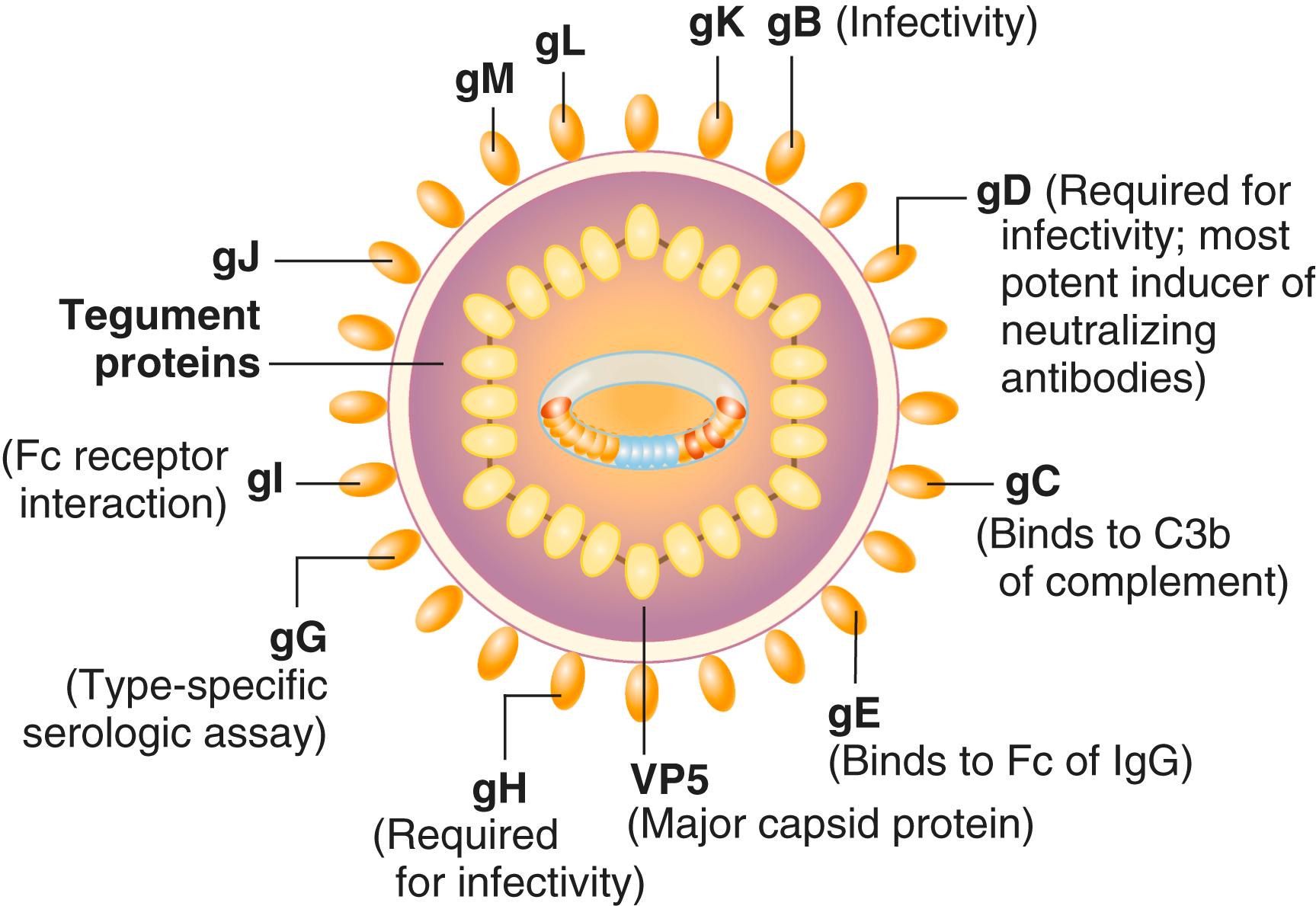
HSV infections are very common worldwide in both developed and developing countries, without any seasonal variations. HSV is transmitted from infected to susceptible individuals during close personal contact; the virus must come in contact with a mucosal surface or abraded skin for infection to be initiated. Because over half of the world’s population has HSV infections and because such infections are rarely fatal, a large reservoir of HSV exists to perpetuate person-to-person transmission. No animal vectors have been identified.
Seroprevalence studies have demonstrated that acquisition of HSV-1 infection is related to socioeconomic and behavioral factors. Antibodies, which indicate past infection, are found early in life among individuals of lower socioeconomic groups, presumably as a consequence of crowded living conditions that provide a greater opportunity for direct contact with infected individuals. Antibodies develop in as many as 75 to 90% of individuals from lower socioeconomic populations by the end of the first decade of life. In contrast, only 30 to 40% of persons in the middle and upper socioeconomic groups are seropositive by the middle of the second decade of life.
Because infections with HSV-2 are usually acquired through sexual contact, antibodies to this virus are rarely found before the onset of sexual activity, but the incidence of HSV-2 progressively increases in all populations beginning in adolescence. Overall, about 15 to 20% of Americans have genital HSV-2 infection. Rates of HSV-2 infection are highest among women, non-Hispanic Blacks, men who have sex with men, and immunocompromised persons, including persons positive for human immunodeficiency virus (HIV; Chapter 358 ). Genital herpes infection is an important risk factor for HIV transmission. ( Chapter 355 ). The lifetime costs of genital herpes infection are estimated to be about $1000 per treated case.
Genital HSV disease occurring during gestation can result in transmission of HSV to the fetus, most frequently resulting from shedding of the virus in genital secretions at the time of delivery. Women who experience a symptomatic or asymptomatic primary infection in the third trimester of gestation have a 30 to 50% risk for transmitting infection to the child. The incidence of cervical shedding in pregnant women with asymptomatic chronic HSV-2 infection is approximately 1%. Most infants who develop neonatal disease are born to women who are completely asymptomatic for genital HSV infection at the time of delivery and who have neither a known history of genital herpes nor a sexual partner who has reported a genital rash.
Replication of HSV is a multistep process ( E-Fig. 345-2 ). After binding of the virion to the host cell and release of the nucleocapsid into the cytoplasm, DNA is uncoated and transported to the nucleus. This release is followed by transcription of immediate-early genes, which encode the regulatory proteins, and is followed sequentially by the expression of proteins encoded by early and late genes. These proteins include structural proteins and enzymes necessary for viral replication.
Assembly of the viral core and capsid takes place within the nucleus. Envelopment at the nuclear membrane and transport out of the nucleus occur through the endoplasmic reticulum and the Golgi apparatus. Glycosylation of the viral membrane occurs in the Golgi apparatus. Mature virions are transported to the outer membrane of the host cell inside vesicles. Release of progeny virus is accompanied by cell death.
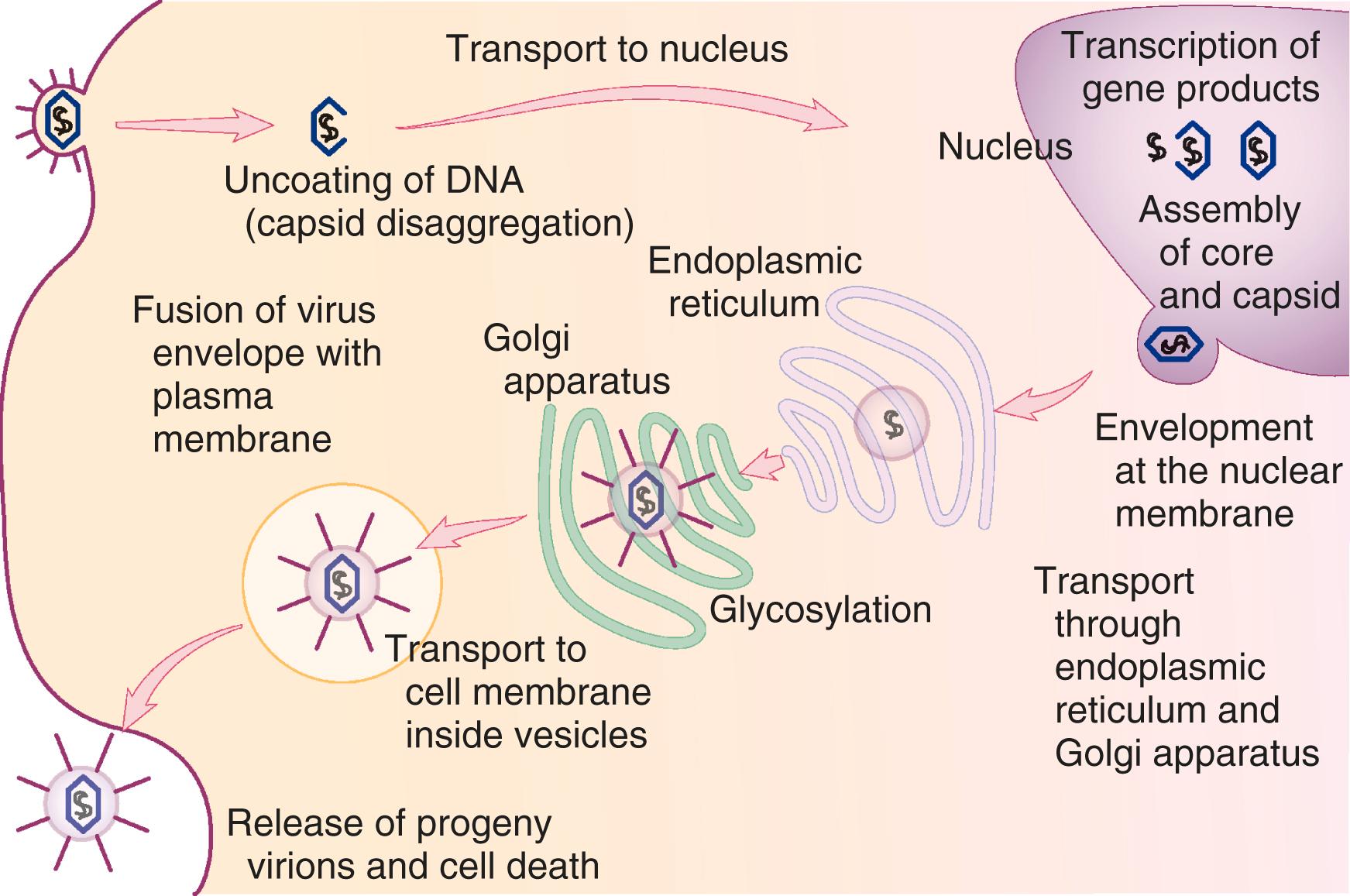
A critical factor for transmission of HSV is intimate contact between a person who is shedding virus and a susceptible host. Following inoculation onto skin or mucous membranes, HSV replicates in epithelial cells; the incubation period is 4 to 6 days ( E-Fig. 345-3 ). Importantly, most primary infections are asymptomatic. In symptomatic patients, cell lysis and local inflammation ensue as replication continues, thereby resulting in the formation of characteristic vesicles on erythematous bases. During primary infection, lymph nodes in the area of viral replication may become enlarged. Viremia may result in visceral dissemination in immunocompromised patients. In all hosts, the virus generally ascends peripheral sensory nerves to reach the dorsal root ganglia. Replication of HSV within neural tissue is followed by spread of the virus to other mucosal and skin surfaces by means of peripheral sensory nerves. HSV replicates further in epithelial cells and reproduces the lesions of the initial infection until infection is contained through host immune responses.
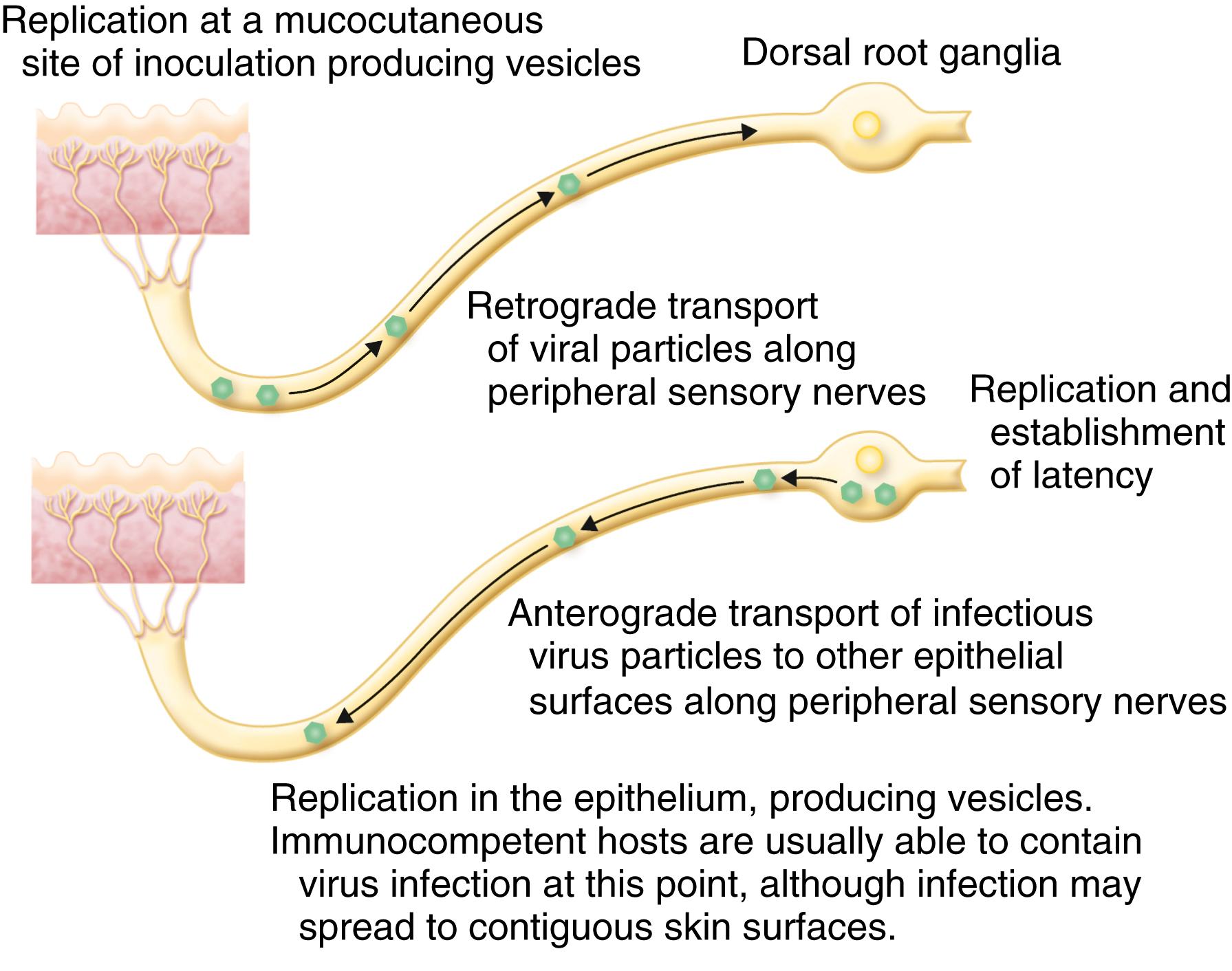
The histopathologic changes induced by HSV replication are similar in both primary and recurrent infection, including ballooning of infected cells and the appearance of condensed chromatin within the nuclei of cells, followed by degeneration of cellular nuclei. Cells lose intact plasma membranes and form multinucleated giant cells. They may also demonstrate intranuclear inclusions, which are known as Cowdry type A bodies, and which are suggestive, but not diagnostic, of HSV infection. With cell lysis, clear vesicular fluid containing large quantities of virus accumulates between the epidermis and dermal layer. The dermis reveals an intense inflammatory response, more so with primary infection than with recurrent disease. As healing progresses, the clear vesicular fluid becomes pustular with the accumulation of inflammatory cells. The pustule ruptures, thereby resulting in an ulcer, which then scabs and heals; scarring is uncommon.
Vascular changes in the area of infection include perivascular cuffing and hemorrhagic necrosis. These changes are particularly prominent when organs other than skin are involved, as is the case with herpes simplex encephalitis or disseminated neonatal HSV infection. As host defenses are mounted, an influx of mononuclear cells is seen in infected tissue.
A unique characteristic of all herpesviruses is their ability to establish latent infection by persisting in an apparently inactive state for varying lengths of time and then reactivating ( E-Fig. 345-4 ). The latent viral genome may be either extrachromosomal or integrated into host cell DNA, depending on the type of herpesvirus.
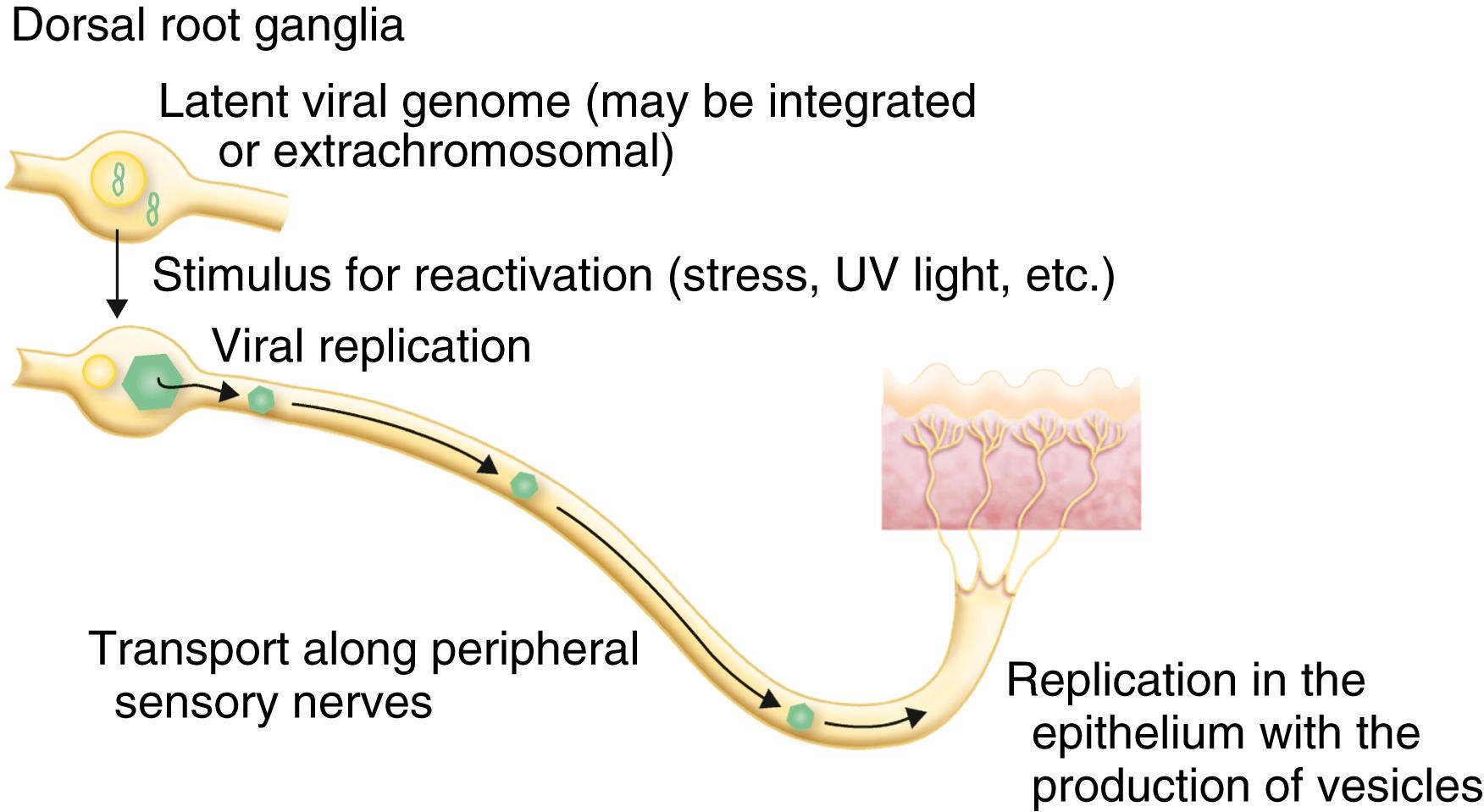
Latency is established when HSV reaches the dorsal root ganglia after retrograde transmission through sensory nerve pathways. Latent virus may be reactivated and enter a replicative cycle at any point in time. Reactivation of latent virus is a well-recognized clinical phenomenon, but the molecular mechanisms remain incompletely understood. Stimuli associated with the reactivation of latent HSV include stress, fever, menstruation, and exposure to ultraviolet light. Precisely how these factors interact with latent virus at the level of the ganglia remains undefined. Reactivation is often clinically asymptomatic, but it may occasionally produce life-threatening disease.
HSV has been used for experimental gene therapy. By removal of the γ 1 34.5 gene, both neurovirulence and the propensity to establish latency are ablated. These engineered viruses are being experimentally tested in patients with glioblastoma multiforme ( Chapter 175 ) and metastatic colorectal cancer ( Chapter 179 ).
Gingivostomatitis (usually caused by HSV-1) occurs most frequently in children younger than 5 years. Illness is characterized by fever, sore throat, pharyngeal edema, and erythema, followed by the development of vesicular or ulcerative lesions on the oral and pharyngeal mucosa. Recurrent HSV-1 infections of the oropharynx, which have a significant adverse effect on quality of life, are most frequently manifested as herpes simplex labialis (cold sores or fever blisters) and usually appear at the vermilion border of the lip ( Fig. 345-1 ). Recurrences are triggered by fever, stress, physical injury, immunosuppression, menstruation, and exposure to ultraviolet light. Intraoral ulcers as a manifestation of recurrent HSV disease are uncommon.
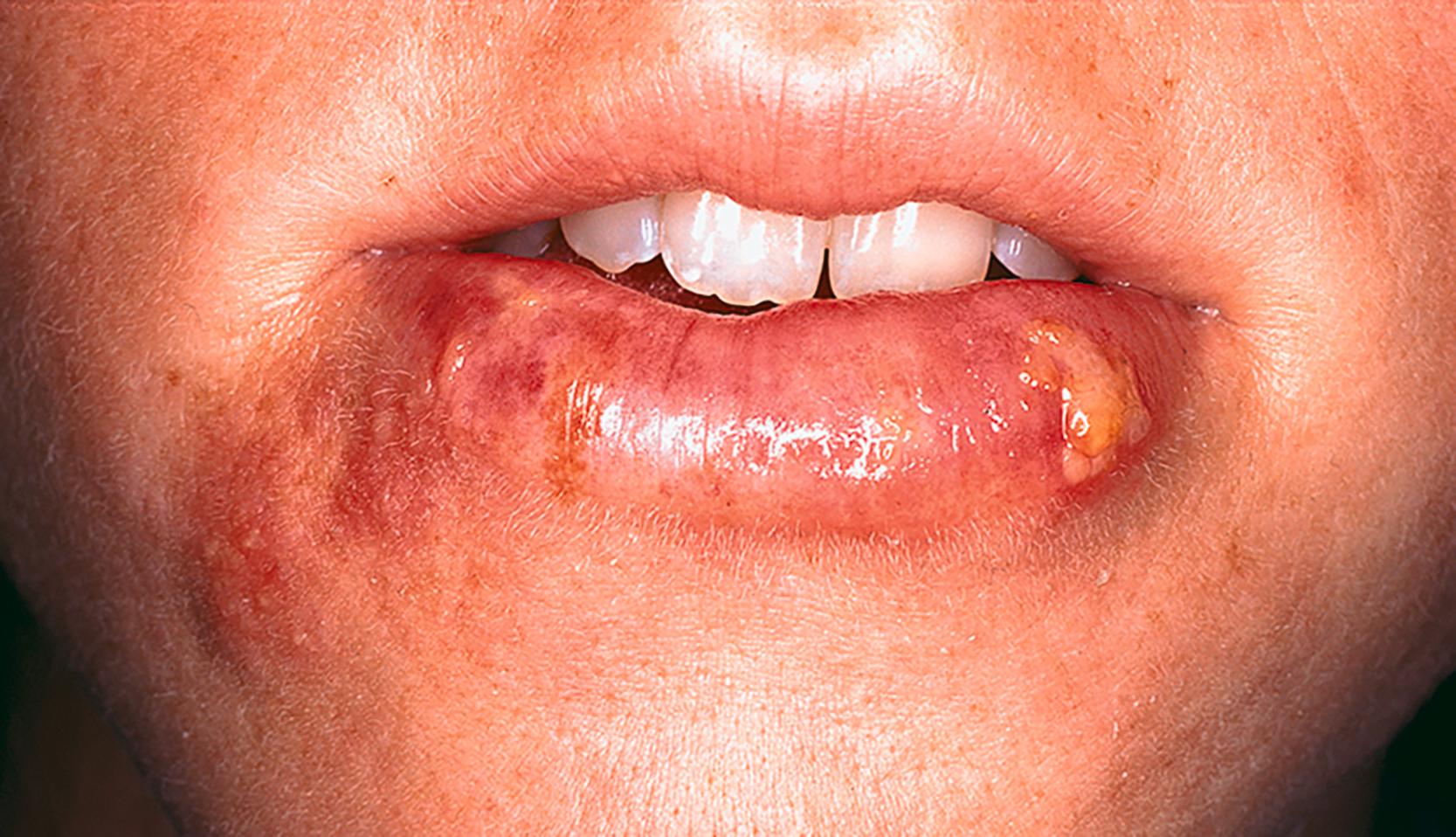
Only 10 to 25% of persons with serologically confirmed HSV-2 infection are aware that they have genital herpes. Investigations using serial polymerase chain reaction (PCR) sampling have shown that 80 to 90% of HSV-2–infected individuals have transient episodes of asymptomatic viral shedding from the genital tract on 10 to 20% of days. Asymptomatic viral shedding from undiagnosed patients is the most common source of new transmissions.
Symptomatic initial infection in women usually involves lesions on the vulva, vagina, and cervix, whereas symptomatic men experience lesions on the glans penis, prepuce, or penile shaft. In the United States, herpes simplex is the most common cause of genital ulcers ( Chapter 264 ). Although genital herpes was historically attributed to HSV-2, over 50% of all initial cases in some populations (especially young women, non-Hispanic Whites, and men who have sex with men) are caused by HSV-1.
In individuals of either gender, primary disease can be associated with fever, malaise, anorexia, and bilateral inguinal adenopathy. Following initial infection, complete healing of lesions may take 2 to 3 weeks. Women frequently have dysuria and urinary retention as a result of urethral involvement. Aseptic meningitis ( Chapter 381 ) develops in as many as 10% of individuals with primary infection. Sacral radiculomyelitis, which may occur in both men and women, results in neuralgias, urinary retention, or obstipation.
The initial episode of genital infection is less severe in individuals who have previously had HSV-1 infections at other sites. Antibodies to HSV-1 appear to ameliorate the clinical severity of initial HSV-2 infection.
Recurrent genital infections in either men or women can be particularly distressing. The frequency of recurrences varies significantly from one individual to another, but is always less frequent with HSV-1 genital disease than with HSV-2. In the first year after initial genital herpes caused by HSV-2, the median number of symptomatic recurrences is four.
Herpes simplex keratitis (see Fig. 391-17 ), which is usually caused by HSV-1 and is often accompanied by conjunctivitis, is considered the most common infectious cause of blindness in the United States. The characteristic lesions of HSV keratoconjunctivitis are dendritic ulcers best detected by fluorescein staining of the cornea. Deep stromal involvement also may result in visual impairment.
Become a Clinical Tree membership for Full access and enjoy Unlimited articles
If you are a member. Log in here